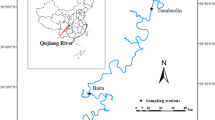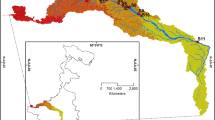Abstract
Pu River is a typical tributary of Liao River basin; in order to investigate water quality variations at different times and spaces in Pu River, the multivariate statistical method was used to analyze 12 water quality indicators measured at 18 different sites in the period from 2012 to 2013. The research assessed water pollution state and factors, identified pollution sources, and proposed some protective measures and schemes to improve the water quality. Based on the water quality indicators monitoring results, spatial hierarchical cluster analysis (HCA) on 18 sampling sites classified, Pu River was classified into four segments, including source clean segment, upstream heavily polluted segment, midstream light polluted segment, and downstream micro-polluted segment. Temporal HCA results on 8 months also performed a significant seasonal variations on heavily pollution in normal river flow period and early flood period. By principal component analysis (PCA), it is founded that the main pollution of Pu River were COD, TOC, BOD5, NH3-N, TP, and chlorophyll a (Chl-a). Among them, COD, TOC, and BOD5 mainly came from industrial pollution sources, NH3-N and TP from domestic pollution sources, and Chl-a from the natural pollution. Combining with the field investigation result, it was found that the upstream and midstream were mainly polluted by the industrial wastewater and domestic sewage, while the downstream were mainly contaminated by agricultural non-point pollution. Therefore, reinforcing the prevention and control of industrial and domestic pollution of upstream region are expected to improve the water quality of Pu River.









Similar content being viewed by others
References
Chinese national environmental monitoring center (CNEMC) (2013) National surface water quality monthly (August) in, Test Report. (in chinese)
Einax JW, Soldt U (1999) Geostatistacal and multivariate statistical methods for the assessment of polluted soils-merits and limitations. Chemometr Intell Lab Syst 46:79–91
Farnham Irene M, Stetzenbach Klaus J, Singh Ashok K (2000) Deciphering ground Water Flow systems in Oasis valley, Nevada, using trace element chemistry, multivariate statistics and geographical information system. Math Geol 32(8):943–968
He X (2011) Multivariate statistical analysis. China Renmin University Press, Beijing, pp 143–154 (in Chinese)
Jing Y (2012) Study on pollution characteristics and improvement approach of Puhe River water quality in Shenyang. Environ Prot Sci 4:29–33 (in chinese)
Kim TH, Chung SY, Park N et al (2012) Combined analyses of chemometrics and kriging for identifying groundwater contamination sources and origins at the Masan coastal area in Korea. Environ Earth Sci 67(5):1373–1388
Li F, Lv C, Wei R, Wang J (2014) Aquatic ecological health assessment of the third level aquatic eco-functional zones for typical tributaries of Liaohe River. Sci Technol Rev 32(1):70–77 (in chinese)
Najar IA, Khan AB (2011) Assessment of water quality and identification of pollution sources of three lakes in Kashmir, India, using multivariate analysis. Environ Earth Sci 66(8):2367–2378
Qi J, Song W (2010) Application of fuzzy mathematics in evaluation of water quality of Puhe River. Sci Technol Innov Her 15(7):139–141 (in chinese)
Shuai F, Jindeng L, Wang X (2007) The evaluation of water quality of Chang Lake based on spatial interpolations. Adm Tech Environ Monit 19(4):40–44 (in chinese)
Simeonov V, Stratis JA, Samara C et al (2003) Assessment of the surface water quality in Northern Greece. Water Res 37(17):4119–4124
Song MW, Huang P, Li F et al (2011) Water quality of a tributary of the Pearl River, the Beijiang, Southern China: implications form multivariate statistical analyses. Environ Monit Assess 172(1–4):589–603
State Environment Protection Administration of China (SEPA) (2002) Methods for water and wastewater monitoring and analysis in China, 4th edn. China Environmental Science, Beijing
Sun H, Shen Y, Yingming X et al (2011) Water quality assessment of Yellow River based on multivariate statistical analysis. J Agro-Environ Sci 30(6):1193–1199 (in Chinese)
Tian YZJ, Huang X (2009) Application of factor analysis and cluster analysis to water quality comprehensive evaluation on Yangtze River. Sci Technol Inf 19:336–337 (in chinese)
Shouye Y, Chongxian L (1999) Multiple statistic study of element geochemical characteristics—element geochemical study on the Changjiang and Huanghe sediments. J Mineral Petrol 19(1):63–67 (in Chinese)
Yu H, Xi B, Jiang J et al (2011) Environmental heterogeneity analysis, assessment of trophic state and source identification in Chaohu Lake, China. Environ Sci Pollut Res 18(8):1333–1342
Zhang N, Meng W, Zhang Y et al (2009) Multi-variable assessment of river ecosystem health in Liao River Basin. Res Environ Sci 22(2):163–170 (in Chinese)
Zhou F, Guo H, Liu Y, Jiang Y (2007) Chemometrics data analysis of marine water quality and source identification in Southern Hong Kong. Mar Pollut Bull 54:745–756
Zhou H, Jiang L, Li F (2008) Water quality evaluation method based on principal component analysis. Math Pract Theory 38(8):86–90 (in Chinese)
Acknowledgments
This work was supported by the Major Science and Technology Program for Water Pollution Control and Treatment (No. 2012ZX07202-005).
Author information
Authors and Affiliations
Corresponding author
Rights and permissions
About this article
Cite this article
Gao, H., Lv, C., Song, Y. et al. Chemometrics data of water quality and environmental heterogeneity analysis in Pu River, China. Environ Earth Sci 73, 5119–5129 (2015). https://doi.org/10.1007/s12665-015-4233-x
Received:
Accepted:
Published:
Issue Date:
DOI: https://doi.org/10.1007/s12665-015-4233-x




